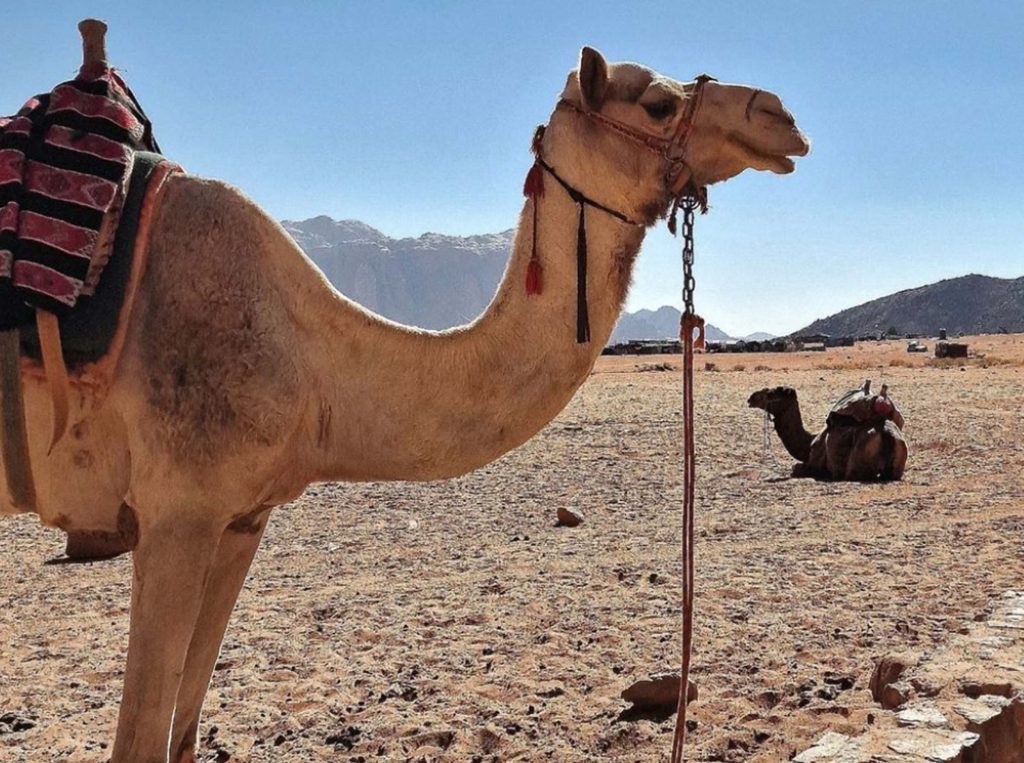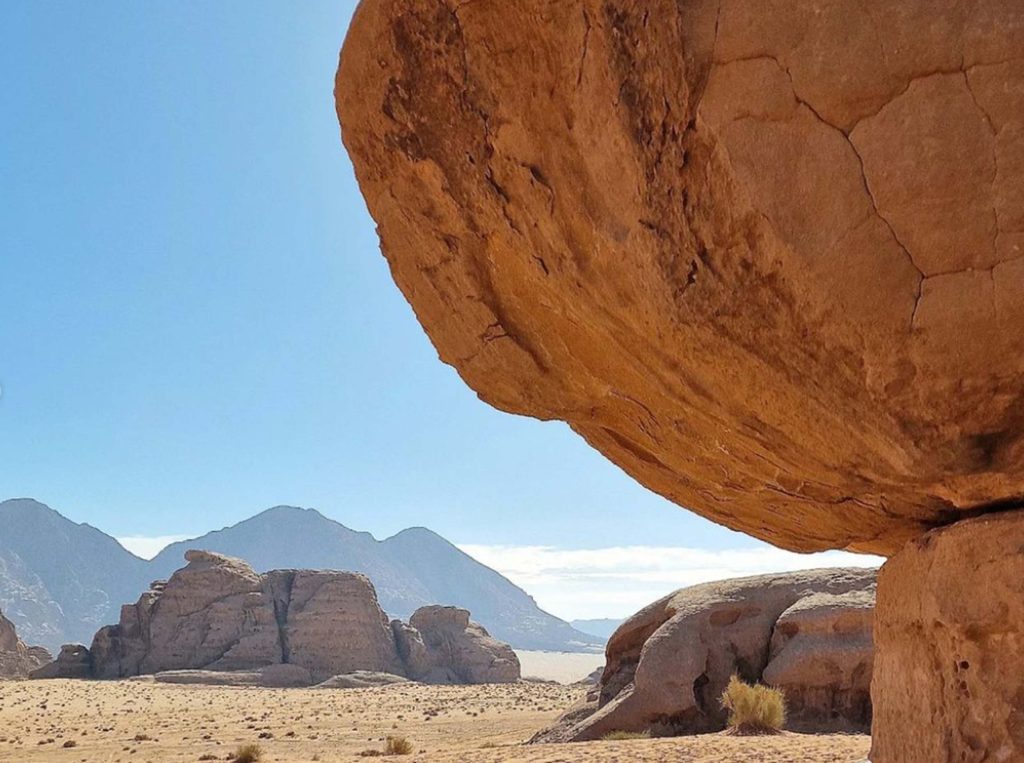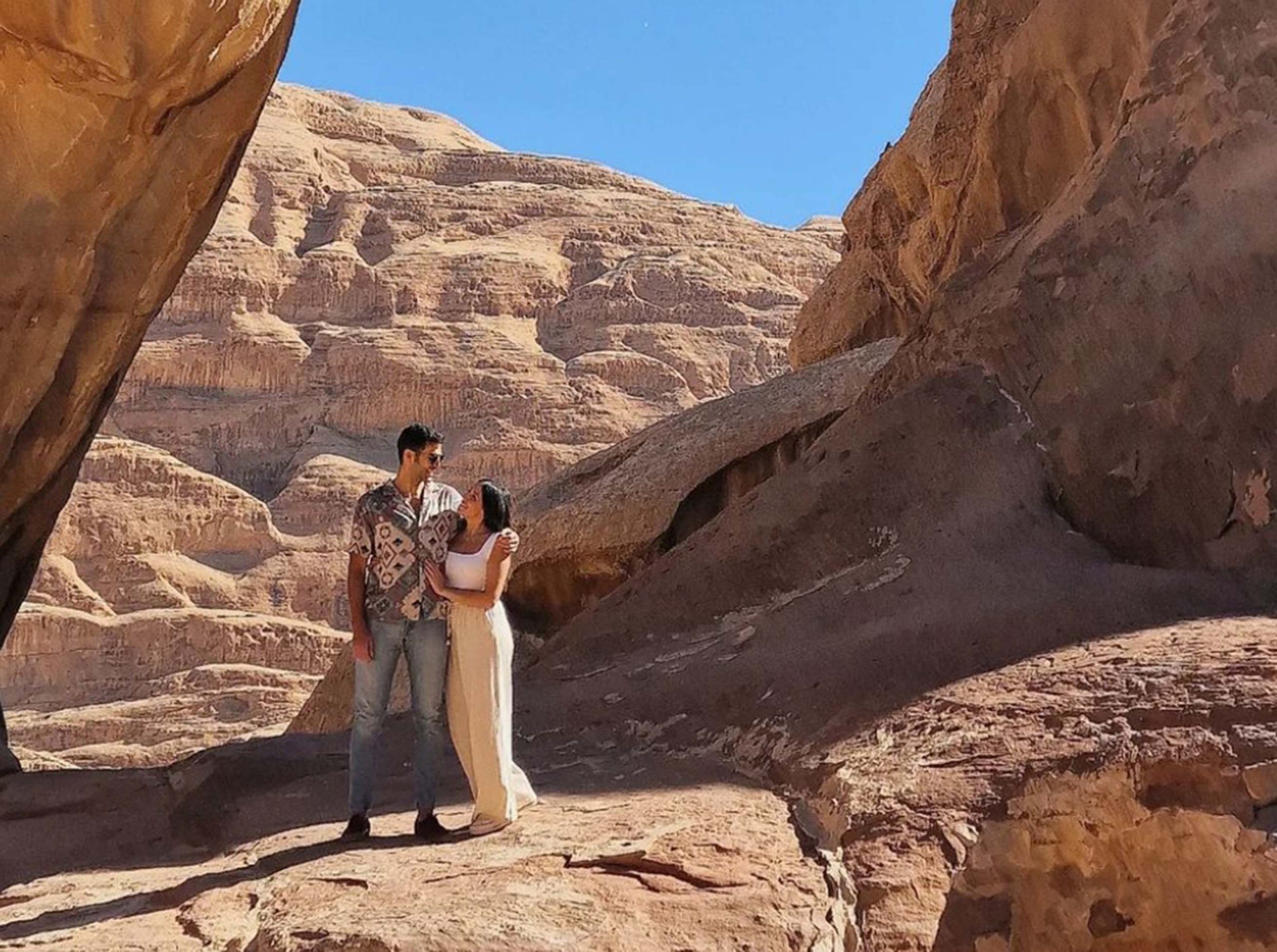Nestled within the golden embrace of Jordan’s Wadi Rum, a realm of timeless wonder and raw beauty awaits. Here, amidst the shifting sands and towering sandstone formations, lie the enigmatic landmarks that narrate tales of millennia. From the rugged grandeur of Khazali Canyon to the silent echoes of Lawrence’s House, each site offers a portal into the ancient, a testament to nature’s artistry and human history. Wadi Rum, etched with the whispers of the past, beckons adventurers to unearth its treasures and witness the fusion of geological marvels and storied legacies.
Khazali Canyon: A Historical Canvas Amidst Majestic Scenery
Landscape Description
Nestled within Wadi Rum’s breathtaking desert landscape, Khazali Canyon is a mesmerizing natural wonder. Its towering sandstone walls, adorned with intricate patterns carved by centuries of wind and water erosion, create a dramatic spectacle. The surrounding vistas paint an awe-inspiring panorama, with rusty-hued cliffs contrasting against the golden sands, creating an otherworldly ambiance that captivates visitors.
Ticket Reservation, Pricing, and Operating Hours
Access to Khazali Canyon is typically included in guided tours offered by local Bedouin guides or tour companies operating in Wadi Rum. The ticket prices and booking methods may vary depending on the chosen tour package and the duration of the visit. Prices can range from around $20 to $50 per person for guided tours that include multiple sites in Wadi Rum. It’s advisable to book tours in advance through reputable tour operators to secure preferred time slots.
Operating hours for tours to Khazali Canyon generally align with daylight hours, typically from early morning to late afternoon. Visitors should check with their chosen tour operator for specific timings and availability.
Historical Background
Khazali Canyon’s historical significance is etched into its walls, adorned with ancient inscriptions and petroglyphs dating back thousands of years. These intricate carvings and drawings tell stories of the region’s past inhabitants, primarily the Bedouin nomads. They depict scenes of daily life, hunting expeditions, religious rituals, and mystical symbols, offering a glimpse into the cultural and spiritual practices of ancient Bedouin societies.
These petroglyphs are believed to have served various purposes, from communicating and documenting daily life events to marking ceremonial sites. For centuries, this canyon has been a sacred place for the Bedouin people, with its engravings holding cultural and historical significance that reverberates through time.
Khazali Canyon stands not just as a geological wonder but as a testament to human history, preserving the stories and traditions of the Bedouin people and serving as a window into the ancient past of Wadi Rum.
Lawrence’s House: Echoes of an Enigmatic Past
Lawrence’s House, nestled in the heart of Wadi Rum’s majestic desert, holds profound historical significance. It stands as a tribute to the enigmatic figure of T.E. Lawrence, more commonly known as Lawrence of Arabia. During World War I, Lawrence, a British officer, played a pivotal role in the Arab Revolt against the Ottoman Empire.
The modest structure of Lawrence’s House served as a refuge for Lawrence during his time in Wadi Rum. This simple dwelling, though unassuming in appearance, holds echoes of Lawrence’s presence and the strategic importance of Wadi Rum during the tumultuous years of the war.
Lawrence’s House stands as a testament to the legacy of Lawrence of Arabia, offering visitors a glimpse into his life and the historical context of the Arab Revolt. Exploring this humble shelter allows travelers to connect with the past, envisioning the challenges and victories of a pivotal era in the region’s history.
Umm Fruth Arch: Nature’s Masterpiece Amidst Wadi Rum’s Splendor
Landscape Description
Umm Fruth Arch, a geological marvel in Wadi Rum, stands as a testament to nature’s artistry. This monumental sandstone archway, sculpted over eons by the elements, graces the desert landscape with its striking beauty. The arch frames the horizon, a natural work of art set against the backdrop of Wadi Rum’s surreal panorama. Its colossal structure, carved by wind and weather, showcases the intricate layers of sedimentary rock, displaying vibrant hues that change with the shifting daylight.
Ticket Reservation, Pricing, and Operating Hours
Access to Umm Fruth Arch is typically included in guided tours offered by local Bedouin guides or tour agencies specializing in Wadi Rum expeditions. The ticket prices for these tours can vary based on the package and the number of sites included, ranging from approximately $20 to $50 per person. It’s advisable to book tours in advance through reputable agencies to secure preferred time slots and ensure a smooth experience.
Operating hours for tours to Umm Fruth Arch usually align with daylight hours, allowing visitors to witness the arch’s beauty in optimal natural lighting. Visitors should confirm the specific timings with their chosen tour operator, as they may vary based on the tour package and seasonal considerations.
Historical Background
The history of Umm Fruth Arch is rooted in the geological evolution of Wadi Rum, shaped over millions of years by natural forces. Its formation, sculpted by the erosive power of wind and water, represents the enduring artistry of nature. While Umm Fruth Arch doesn’t have direct historical associations like some other sites in Wadi Rum, it symbolizes the timeless narrative of geological transformation that characterizes this desert landscape.
As visitors stand beneath the arch’s colossal span, they witness the geological tale etched in its layered rocks, each stratum a chapter in Wadi Rum’s ancient history. The arch serves as a silent witness to the forces that shaped this desert over millennia, inviting travelers to contemplate the sheer magnificence of natural sculpting and the passage of time.
Camels: Navigating the Sands, Embracing Tradition

Desert Landscape:
Wadi Rum’s scenery is a tapestry of awe-inspiring landscapes—towering sandstone mountains, vast sand dunes, and a maze of canyons and valleys. The landscape is a symphony of colors, with the sun painting the sands in hues of red and gold at sunrise and sunset. Its natural beauty, rugged terrain, and silence create an otherworldly ambiance that captivates visitors.
Camels in Wadi Rum:
Camels have been essential companions for Bedouins navigating the desert for centuries. In Wadi Rum, these serene creatures offer a genuine and immersive experience. Visitors have the opportunity to ride camels guided by experienced handlers, allowing them to embrace the traditional Bedouin way of traversing the sands. The experience allows for a deeper connection to the region’s cultural heritage and offers a slower-paced exploration of the desert’s vastness.
Historical Significance:
Camels have played a significant historical role in desert civilizations. They were fundamental to the survival and trade of ancient Bedouin tribes, serving as transportation across the vast and often harsh desert landscapes. While there might not be a specific historical story linked to camels as an attraction, their presence in Wadi Rum represents the enduring traditions and historical significance of Bedouin culture in this desert expanse.
Mushroom Rock: Nature’s Sculpted Wonder

Desert Landscape:
Wadi Rum’s landscape is a canvas painted by the wind and time itself. Vast expanses of sand stretch endlessly, interrupted by towering rock formations and sculpted sandstone mountains. The colors shift dramatically throughout the day, from the warm, glowing hues of sunrise to the deep, fiery tones of sunset, creating a breathtaking panorama that mesmerizes visitors.
Mushroom Rock:
Mushroom Rock, an emblematic formation, is an artistic marvel sculpted by natural forces. Its distinct shape, resembling a mushroom with a massive cap atop a slender stem, has been meticulously crafted by wind erosion over eons. This landmark captivates the imagination, inviting contemplation on the intricate processes that have shaped the desert’s unique topography.
Ticketing and Visitation:
In Wadi Rum, access to natural landmarks like Mushroom Rock generally doesn’t require a specific entrance ticket. Visitors often explore these formations as part of guided tours or private expeditions organized by local Bedouin guides or tour operators. Prices and booking procedures for these tours can vary based on the chosen tour package, the duration of the excursion, and additional inclusions like transport, meals, and camping.
Historical Significance:
While Mushroom Rock doesn’t have a specific historical narrative tied to it, the entire landscape of Wadi Rum holds deep historical and cultural significance. This desert has served as a crossroads for ancient trade routes, a shelter for nomadic tribes, and a backdrop for historical events. The rock formations, including Mushroom Rock, stand as witnesses to the passage of time and the enduring forces of nature that have shaped this region for millennia. Their existence is a testament to the timeless beauty and geological evolution of Wadi Rum.
As the sun sets over Wadi Rum’s vast expanse, casting its final rays upon the towering rocks and the silhouettes of age-old formations, a profound sense of awe lingers. Each landmark visited, from the adorned walls of Khazali Canyon to the arching beauty of Umm Fruth, leaves an indelible mark—a tapestry woven with history, nature’s artistry, and the echo of ancient footsteps. Wadi Rum stands as a sanctuary where time stands still, inviting all who venture here to embrace its secrets, to ponder its magnificence, and to depart, enriched by its tales, forever carrying a piece of the desert’s heart.
